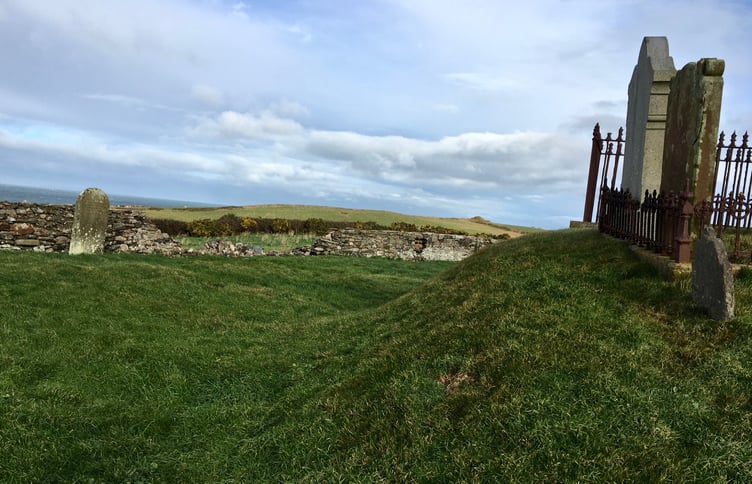Two 1,000 year old Manx crosses have been found on the grounds of Jurby Church.
The crosses are thought to be from the 11th century.
Following a storm last year, Sandra Kerrison, a Jurby Church warden, had been alerted to a part of the wall that had collapsed, near to the viking burial mound, by local photographer Peter Killey.
Sandra said: ‘There was a large piece of slate which seemed to have been carved and in a photo a pattern could be seen.
‘I sent photos to Andrew Johnson, inspector of ancient monuments at Manx National Heritage, and when he visited the site a few days later he confirmed this was a Manx cross with a unique pattern and that he had also found another small cross nearby.’
Mr Johnson said: ‘The stones probably come from the site of an early chapel (a ‘keeill’) and burial ground.
‘When the old parish church was built around 1700, some of the larger crosses were broken up and used in its masonry.
‘After the present church was completed in the early 1800s, the old church was demolished and stone from it was recycled to build the current perimeter wall defining the burial ground. Two or three other crosses have been recovered from the wall over the past two centuries.’
Mrs Kerrison said: ‘Before the churchyard collapsed little was known about the Jurby Church keeill, its age, significance or its location.
stoup
‘The small cross thought to date from AD 600 and a previous find of a stoup, a holy water cup, buried deep in a grave, which could have been a similar age, indicate the possible age of the site.
‘The keeill may not have been where the old church was, near to the war memorial, but lower down the hill where the current burial ground is. The Manx Cross thought to have been from around AD 1000 could have been part of a large cross outside the church gate which has been referred to in the past.
‘Most of the Manx Crosses found at Jurby Church had been placed inside the wall or were part of the wall which we now know was built after the current building was completed (in the early 1800s).
‘It would seem that any ruins from the keeill and stones around it were cleared away and used as building material for the wall, with some of the more striking pieces being saved.
‘It is likely that there will be other pieces of crosses in the wall but it may be another 200 years before they are found.’
Mr Johnson added: ‘Just over 200 crosses have beens found throughout the island, most of which have been gathered and displayed at the historic parish churches. The great majority of the crosses have been found at the sites of the old keeills.’
According to Mr Johnson, around 30 crosses have been found in the last 40 years.
He said: ‘The larger of the two crosses is just a part of a much larger slab which was broken up several hundred years ago.
‘Despite being incomplete, there is enough of the carving preserved to show that it has a unique interlace pattern which has never been seen on other Manx medieval sculpture before, which is very exciting for the experts.
‘Not only does it contribute something new to the island’s art history, but we are also seeing the individual skill and artistry of an individual sculptor, who had found a new way to create his personal interpretation of the interlace patterns that were so popular at the time in the 11th century.
‘The Manx crosses are a unique collection within these islands: they range in date from the 6th to the 13th centuries, display an extraordinary diversity of artistry and skill in the ways that they are carved and the patterns and figures that are recorded, the languages that are used in their inscriptions, and the scripts that are used to write them.’
Mrs Kerrison said: ‘The focus of the Friends of Jurby Church fundraising this summer is for a cabinet to display the crosses when they return to Jurby Church.’




-(1).jpeg?width=209&height=140&crop=209:145,smart&quality=75)
Comments
This article has no comments yet. Be the first to leave a comment.